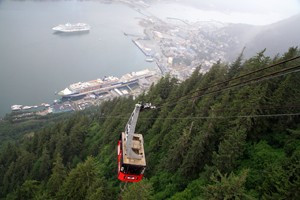
Dubbed the “last frontier”, Alaska is a vast wilderness twice the size of Texas, a mix of towering mountains, lush forests, dramatic glaciers, and over four million acres of national parks flanked by 76,000 kilometres of rugged shoreline. Its epic beauty and natural wonders rank it among the world’s best as an outdoor playground, and one which provides diverse experiences for travellers depending on the time of year they visit.
The winter months, between November and April are extremely cold and marked by increasing snow and ice the further north you venture. Such conditions, however, lend themselves to top quality skiing, cross-country skiing, and snowshoeing, where you float over the ice using special footwear. There’s also dog mushing; travelling by sled or cart, powered by a team of dogs. Winter, however, is also an ideal time of year to experience the famous aurora borealis, or Northern Lights. They’re caused by collisions between electrically charged particles from the sun passing into the earth’s atmosphere, and shine at night. And if you’re an art lover, the World Ice Art Championships take place in Fairbanks in February and March, featuring over 100 artists, and drawing more than 45,000 visitors from across the globe.
During Alaska’s warmer months - April to September - the snow and ice melts, offering all types of travellers a long and alluring list of options, from dogsledding and scenic flights, to glacier hiking, salmon fishing, and kayaking. There’s also no shortage of marine life and wildlife to enjoy, including humpback whales and sea lions in the waterways, American bald eagles overhead, and bears, caribou and moose on land. At this time of year, many visitors take to water to cruise Alaska’s famed Inside Passage. It’s one of the most popular way to experience the forty-ninth state, and ideal for all the family, cruising through dramatic landscapes draped with lush scenery, towering peaks, deep fjords, tiny islands, and with abundant wildlife. There’s also many quaint and classic towns to explore along the way including Juneau, Skagway, Haines, and Ketchikan, all of which have all played a vital role in the region’s colourful history.
If you’re more adventurous, and in the mood for independent travel, however, renting an RV or motorhome is another option, and a way experience what Alaska has to offer on your own time. “Doing” the Alaska Highway will earn you some bragging rights with seasoned travellers, but remember distances between destinations can be long, with some roads unpaved and unsuitable for RVs. Finally, for those who yearn for the golden age of train travel, there are two main rail journeys on offer. The Alaska Railroad extends from Seward to Fairbanks by way of Anchorage, Wasilla, Talkeetna and Denali National Park, while the White Pass and Yukon Route runs from Skagway to Fraser in British Columbia.
Alaska Facts
Alaska’s high season is June to August, with the weather at its warmest, daylight hours longest, and prices for accommodation at their high. Cruise season is usually May to September.
The time difference between Anchorage and AEST is +17 without daylight saving, or +19 hours with daylight saving.
The capital of Alaska is Juneau, but you can only travel there but plane or boat.
There are international airports at Anchorage and Fairbanks, and you can make easy connections to various airports in the USA.
Primary cruise ship departure points include San Francisco, Seattle, Vancouver and Juneau.
- By:
- Ben Hall










